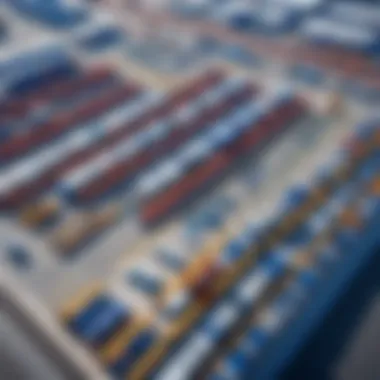Understanding Yard Monitoring Systems: Benefits & Trends


Intro
Yard monitoring systems play a crucial role across diverse industries, serving as a backbone for logistics management, security, and operational productivity. Understanding the intricacies of these systems is essential for decision-makers, IT professionals, and entrepreneurs looking to enhance their operations. This article dissects the fundamental aspects of yard monitoring systems, emphasizing their strategic importance in today's fast-paced business environment.
Adopting these systems not only improves efficiency but also mitigates potential risks related to security and operational downtime. As industries evolve, the requirements for greater transparency, tracking, and management of resources escalate. Therefore, a comprehensive grasp of yard monitoring technology, alongside its implementation strategies, presents a significant competitive advantage.
Key Software Features
Essential functionalities
Yard monitoring systems encompass a variety of essential functionalities that support effective operations. These include:
- Real-time Tracking: Continuous monitoring of assets, equipment, and inventory.
- Data Analytics: Collection and analysis of operational data to inform decision-making and operational strategies.
- Alert Systems: Notifications triggered by specific events such as breaches, equipment failures, or inventory shortages.
- Integration Capability: Seamless interaction with existing systems to ensure smooth operations across platforms.
A robust yard monitoring system integrates these functionalities into a coherent platform, enabling businesses to streamline their processes.
Advanced capabilities
Moving beyond basic functionalities, advanced features in yard monitoring systems offer additional layers of efficiency. These may include:
- Automated Reporting: Generating reports automatically, reducing the time spent on manual documentation.
- Predictive Analytics: Utilizing historical data to forecast demands and prevent potential issues before they arise.
- Mobile Accessibility: Allowing users to access monitoring systems through mobile devices for flexibility and real-time updates.
Such capabilities can significantly enhance productivity, providing users with tools to make informed decisions swiftly.
"Investing in modern yard monitoring systems can lead to substantial operational improvements and cost savings for businesses, in both the short and long term."
Comparison Metrics
Cost analysis
Evaluating yard monitoring systems requires a thorough cost analysis. Businesses need to consider both initial investment costs and ongoing maintenance expenses. A detailed understanding of pricing structures can help in choosing an option that maximizes return on investment.
Moreover, comparing various providers encompassing factors like installation fees, subscription models, and support services plays an integral part in decision-making.
Performance benchmarks
Performance benchmarks provide insights into the effectiveness of yard monitoring systems. Key metrics for evaluation include:
- Accuracy of Tracking: The reliability of asset tracking within the system.
- Response Time: The speed at which the system alerts users to issues.
- User Satisfaction: Feedback from end-users regarding usability and reliability.
By focusing on these metrics, decision-makers can better assess which yard monitoring system aligns with their operational requirements and strategic goals.
Defining Yard Monitoring Systems
Yard monitoring systems are integral to the operational framework of numerous industries. These systems offer the means to oversee activities and assets within a designated area, typically a yard or storage facility. The effectiveness of yard monitoring systems can significantly influence logistical efficiency, security protocols, and overall organizational productivity. This section articulates the core aspects of yard monitoring systems, detailing their concepts and widespread relevance.
Concept and Purpose
Yard monitoring systems serve a specific purpose: to provide real-time visibility into the activities occurring within a yard. This involves tracking assets, monitoring personnel, and ensuring the security of materials. The concept encompasses several components, including hardware for surveillance and software solutions for data analysis.
The purpose of these systems extends beyond mere observation. They enable businesses to streamline operations by pinpointing inefficiencies and potential bottlenecks. Furthermore, enhanced tracking capabilities lead to better accountability and improved resource management. As companies strive for more efficiency, the implementation of effective yard monitoring systems becomes not just beneficial, but essential.
Importance in Various Industries
The application of yard monitoring systems spans multiple industries, each benefiting uniquely from the capabilities these systems provide. In logistics and transportation, companies utilize these systems to optimize loading and unloading processes. This minimizes downtime and maximizes throughput, thereby contributing to better customer satisfaction.
In manufacturing, yard monitoring supports the management of raw materials and finished goods. By maintaining an accurate overview of inventory levels, businesses can avoid overstocking or stockouts.


In the field of security, yard monitoring systems play a crucial role in safeguarding assets. They deter unauthorized access and provide valuable data in case of incidents. This multi-industry appeal highlights the strategic importance of yard monitoring systems.
"The ability to oversee and analyze yard operations can transform logistics and security measures into proactive strategies rather than reactive responses."
The adoption of these systems aligns with the increasing demand for data-driven decision-making.
Overall, the relevance of yard monitoring systems is reflective of broader trends towards efficiency and security in our fast-paced industrial landscape. Their strategic importance can not be overstated as organizations continue to seek advanced solutions for complex challenges.
Components of Yard Monitoring Systems
Understanding the components of yard monitoring systems is crucial for grasping how they function and the efficiency they bring to various operations. These systems do not operate in isolation. Each element plays a key role in creating a comprehensive solution for monitoring and managing yard environments. This section breaks down the essential components, focusing on hardware, software, and user interfaces, while also highlighting their significance and interconnectedness in yard monitoring.
Hardware Requirements
The hardware is the backbone of any yard monitoring system. It includes all the physical devices needed to collect data and transmit information. Common components in this category might include:
- Cameras: CCTV cameras are essential for real-time surveillance. They help in monitoring activity within the yard and act as a deterrent against security breaches.
- Sensors: Various sensors, such as motion detectors and environmental sensors, help gather crucial data about yard operations.
- RFID Readers: RFID technology is often utilized for tracking assets. Readers capture information from tagged items, offering insights into movements within the yard.
- Terminals and Displays: These allow users to access the system’s data. They provide a visual interface for users to monitor real-time activities.
Adequate hardware ensures reliability and efficiency in data collection. A lack of suitable hardware can result in data gaps, leading to poor decision-making in operations. Organizations must evaluate their specific needs before investing in hardware to ensure the components align with operational goals.
Software Solutions
Software is equally vital in yard monitoring systems. It processes the data gathered by hardware components and provides actionable insights. Effective software solutions can vary widely but generally include:
- Data Management Software: This allows users to organize and analyze data from multiple sources. Having a robust management platform assists in tracking operations over time.
- Monitoring Applications: These applications provide real-time alerts and updates, enabling decision-makers to react swiftly to any issues or anomalies in the yard.
- Integration Software: Many organizations use various systems, such as inventory management or dispatching. Integration software ensures that the yard monitoring system communicates effectively with these platforms, streamlining operations.
The choice of software solutions can significantly impact the overall performance of yard monitoring systems. Good software enhances data visibility and ensures that users can make informed decisions based on real-time information.
User Interfaces
User interfaces (UIs) are what make the communication between humans and machines possible. The effectiveness of a yard monitoring system largely depends on how user-friendly the UI is. Effective UIs should have:
- Intuitive Layout: The design should be straightforward, allowing users to navigate easily through information. Complexity can lead to frustration and errors.
- Customizable Dashboards: Allowing users to create personalized views of data can enhance focus on specific metrics relevant to them. This feature caters to various roles within an organization, providing targeted insights.
- Mobile Accessibility: As operations often occur in various locations, mobile-friendly interfaces enable users to monitor yard metrics from anywhere.
Good UIs not only enhance usability but also improve training and adoption rates across organizations. If the interface is easy to understand, users are more likely to embrace the technology.
"The integration of hardware, software, and user interfaces forms the core of yard monitoring systems. Each component must work together seamlessly to achieve optimal results."
Types of Yard Monitoring Systems
Yard monitoring systems play a vital role in various sectors, and understanding the types is crucial for effective implementation. Each type of system serves specific purposes, thus addressing unique challenges in logistics and security. When businesses recognize these variations, they can better tailor their strategies for optimal performance.
CCTV Systems
Closed-Circuit Television (CCTV) systems are among the most common yard monitoring solutions. They consist of cameras, recorders, and monitors that provide a real-time view of yard activity. These systems offer several advantages.
- Enhanced Surveillance: CCTV systems provide continuous monitoring, deterring unauthorized access and potential theft.
- Evidence Recording: The recorded footage can be crucial for investigations, offering concrete evidence in cases of security breaches.
- Remote Access: Many modern CCTV systems allow users to access their feeds remotely through mobile devices, increasing convenience and responsiveness.
The implementation of CCTV significantly improves security protocols, making it a preferred choice for businesses aiming to safeguard their assets.
RFID Tracking Solutions
Radio Frequency Identification (RFID) tracking solutions utilize tags and readers to monitor the movement of goods and equipment within a yard. This technology serves various industries effectively.
- Asset Management: RFID enables precise tracking of inventory, reducing loss and misplacement of valuable items.
- Increased Efficiency: The ability to scan multiple items quickly streamlines operations compared to manual tracking methods.
- Data Accuracy: RFID systems minimize human error, ensuring that data collected is reliable and timely.
Businesses employing RFID tracking can expect a smoother flow of operations, ultimately enhancing overall productivity.


GPS-Based Systems
Global Positioning System (GPS)-based systems provide geographic tracking solutions for vehicles and equipment within a yard. Their benefits include:
- Real-Time Location: GPS allows managers to track the location of assets, ensuring effective utilization.
- Route Optimization: Data from GPS devices can help in planning efficient routes, saving time and fuel costs.
- Geofencing Capabilities: Alerts can be set up to notify managers when assets enter or leave predefined zones, enhancing security.
The ability to respond quickly to real-time location data empowers businesses to manage their resources better.
Integrated Software Platforms
Integrated software platforms combine various monitoring technologies into a cohesive system. This type of yard monitoring solution enhances overall operational capabilities.
- Centralized Management: Users can manage CCTV, RFID, and GPS information from a single interface, promoting efficiency.
- Comprehensive Analytics: These platforms can aggregate data from multiple sources, providing insights that can inform strategic decisions.
- Scalability: Businesses can easily adapt integrated systems as they grow or change, making them a long-term investment.
Benefits of Implementing Yard Monitoring Systems
Implementing yard monitoring systems brings several significant benefits. These systems serve as a backbone for optimizing logistics and enhancing operational procedures. Understanding these advantages is essential for decision-makers and organizations looking to improve productivity and security.
Operational Efficiency
Operational efficiency is perhaps the most crucial benefit of yard monitoring systems. By providing real-time visibility into yard activities, these systems streamline operations. They enable managers to track the flow of vehicles, equipment, and materials. In addition, they help in reducing wait times and minimizing bottlenecks. For instance, managers can utilize data analytics to predict peak times and allocate resources appropriately, thus enhancing the overall productivity. Efficient resource allocation leads to a better throughput, ensuring that operations run smoothly without delays.
Enhanced Security Protocols
Another significant advantage is enhanced security protocols. Yard monitoring systems allow organizations to maintain a secure perimeter. With the integration of technologies such as CCTV and RFID, it becomes easier to monitor access points and detect unauthorized entry. Security personnel can respond swiftly to any unauthorized activity, minimizing threats. Moreover, cameras provide a recorded history of events that can be invaluable in investigations. A robust security protocol not only protects assets but also fosters a safer working environment for employees.
Real-Time Data Access
Real-time data access is another benefit that cannot be overlooked. By implementing these systems, organizations can gather and access critical data instantaneously. This data can include the location of assets, inventory levels, and operational metrics. Quick access to such data supports informed decision-making. Managers can identify trends and respond to issues as they arise. For example, if a vehicle is stuck in traffic, decision-makers can reroute other vehicles to maintain workflow efficiency. This kind of agility can significantly contribute to a more dynamic operational framework.
Cost Reduction Strategies
Lastly, implementing yard monitoring systems leads to effective cost reduction strategies. Organizations can identify areas of waste and inefficiency. By analyzing data, it is possible to trim excess labor costs or reduce fuel expenses. In addition, better asset tracking leads to fewer misplaced items, saving money in replacements. Effective utilization of resources further reduces operational costs. On a larger scale, these systems can lead to measurable ROI, justifying the initial investment in the technology.
"Incorporating yard monitoring systems is not just about technology; it's a strategic move for long-term sustainability and efficiency."
In summary, the benefits of yard monitoring systems extend far beyond mere monitoring. They touch on operational efficiency, security, real-time insights, and the potential for significant cost savings. Understanding these aspects can empower businesses to make informed decisions regarding their implementation.
Challenges to Consider
While yard monitoring systems offer significant advantages, their implementation is not without challenges. Understanding these obstacles is crucial for businesses that seek to optimize their logistics and operational capacities. Focusing on these challenges enables organizations to make informed decisions. As a strategic initiative, addressing these factors ensures a smoother transition into more advanced monitoring systems.
Initial Investment Costs
Financial commitment is often the first hurdle that companies face. Initial investment costs can be substantial, involving hardware components, software licenses, and installation fees. Depending on the size of the operation and the complexity of the system, businesses may find the expenditure daunting. It is essential to assess whether the long-term gains justify these upfront expenses. Firms that perform a thorough cost-benefit analysis often recognize that these investments lead to improved efficiencies and long-term savings, particularly in large-scale operations.
Integration with Existing Systems
Another significant challenge is the integration of new yard monitoring systems with existing infrastructure. Many companies utilize older systems that may not be compatible with modern technologies. This incompatibility can lead to inefficiencies or data silos, where information does not flow seamlessly from one system to another. To mitigate this issue, organizations should conduct a comprehensive assessment of their current systems before implementation. A well-planned integration strategy is essential for ensuring that all systems communicate effectively, maximizing the potential of the new monitoring technology.
Training and User Adoption
The success of yard monitoring systems also hinges on user adoption. Employees at all levels must be adequately trained to use the new systems effectively. This challenges organizations to invest time and resources into comprehensive training programs. Employees may resist change, especially if they are accustomed to previous methods. Creating a culture of adaptability can help in overcoming this resistance. Involving employees in the transition process can enhance their buy-in, leading to a smoother adoption of the new technology.
Privacy and Data Security Concerns
Finally, privacy and data security are at the forefront of discussions about yard monitoring systems. As these systems often collect sensitive information, ensuring its protection becomes paramount. Companies must adhere to data privacy regulations, such as the General Data Protection Regulation (GDPR), to avoid legal repercussions. Implementing robust security measures, including encryption and regular audits, is critical. Organizations should foster a climate of trust by being transparent about how data will be collected and used. This fosters confidence among employees and stakeholders in the organization's commitment to data protection.


Implementation Strategies
The process of implementing yard monitoring systems is vital for a successful integration into business operations. Effective strategies ensure that a system is tailored to meet specific demands and is fully functional upon deployment. Businesses must consider several key elements to develop a robust implementation plan. Drawing upon experience and insights is essential to avoid common pitfalls and barriers.
Assessment of Needs
Before selecting any technology, a thorough assessment of needs is crucial. This ensures that the yard monitoring system aligns with the operational goals of the organization. Identifying specific requirements includes evaluating current logistics, potential security threats, and workforce efficiency. A systematic approach often involves interviews with stakeholders, data analysis regarding yard functionality, and consultation with industry experts.
In addition, organizations need to consider scale and future growth. Understanding the scope of operations, whether regional or national, provides clarity on the expected scale of monitoring. This phase sets the foundation for all subsequent steps, as it defines the precise objectives for the monitoring system.
Selecting the Right Technology
The next step after the assessment is technology selection. Yard monitoring comprises various technological options, including CCTV, RFID, and GPS-based systems. Each type offers distinct functions and benefits that can enhance operational outcomes. It is essential for decision-makers to choose a technology that best addresses the specific needs identified during the assessment phase.
A multifaceted approach is often beneficial. Engaging with vendors, comparing specifications, and evaluating ease of integration with existing systems should form part of the decision-making process. Clarity regarding budget limitations also plays a significant role in this stage. This allows for a more focused evaluation of what features can be included without overspending.
Pilot Testing Phases
Once the appropriate technology is selected, pilot testing becomes the next natural step. This involves deploying the yard monitoring system on a small scale to evaluate performance and functionality. During this phase, organizations can gather valuable data on how well it meets operational goals. Issues or deficiencies can be identified and addressed early on.
Pilot testing often involves operational teams who will use the system day to day. Collecting feedback from these users is vital to understanding the real-world application of the technology. This feedback is pivotal in adjusting configurations for optimal outcomes.
Feedback and Iteration Processes
After implementing a pilot, it is important to establish an ongoing feedback loop. This iterative process ensures that the yard monitoring system continues to evolve. Regular assessments and updates based on user experiences can greatly enhance system performance over time.
Encouraging open channels of communication among users can provide insights that will guide future adjustments and improvements. For example, user feedback can inform necessary training adjustments or highlight features needing further development.
Transitioning systems can be challenging; however, maintaining a focus on continuous improvement can significantly mitigate these concerns. Ultimately, embracing a culture of feedback strengthens the overall aim of optimizing yard monitoring systems.
Future Trends in Yard Monitoring Systems
The evolving landscape of yard monitoring systems indicates a substantial shift towards leveraging advanced technologies. As industries strive for enhanced security, operational efficiency, and logistical excellence, understanding future trends in yard monitoring systems becomes crucial. Organizations must prepare for strategic implementations that integrate cutting-edge tools while navigating the associated challenges and considerations.
Integration with AI and Machine Learning
Integrating artificial intelligence and machine learning into yard monitoring systems is becoming more prevalent. These technologies enhance data analysis capabilities, allowing for real-time decision-making processes. Automated anomaly detection, for example, can swiftly identify unusual behaviors or patterns in yard activities. This capability not only improves security measures but also allows for proactive maintenance of equipment, thereby preventing potential downtime. By using predictive analytics, companies can better forecast inventory movements and operational bottlenecks, optimizing resource allocation across the board.
Advancements in IoT Applications
The Internet of Things (IoT) is revolutionizing how yard monitoring systems collect and share data. With IoT devices, companies can achieve seamless communication between physical assets and digital systems. Sensors placed throughout a yard can continuously gather data on equipment location, usage statistics, and environmental conditions. The integration enables dynamic monitoring of yard spaces, translating collected data into actionable insights. This capability not only streamlines operations but also enhances safety protocols by allowing real-time responses to potentially hazardous situations.
Improved User Experience Design
User experience design is another significant trend in the development of yard monitoring systems. As technology advances, the focus shifts toward creating intuitive interfaces that cater to the needs of the users. Effective design simplifies complex functionalities, making it easier for personnel to understand and act on the data presented. Customizable dashboards and mobile accessibility empower users to monitor operations from various devices. Thus, organizations can ensure smoother adoption rates among staff, leading to increased efficiency in yard management operations.
As business environments become more dynamic, embracing future trends allows organizations to stay competitive and secure in their operations.
Culmination
The conclusion serves as a critical reflection on the topic of yard monitoring systems and their strategic importance. It synthesizes the insights shared throughout the article, emphasizing the necessity of such systems in today's fast-paced business environment. With various industries relying on logistics, security, and operational efficiency, yard monitoring systems are not just tools, they are essential components that facilitate seamless operations.
Final Thoughts on Yard Monitoring Efficiency
Yard monitoring systems enhance operational workflows. By ensuring accurate tracking and efficient management of assets, these systems reduce errors and improve time management. Real-time data access allows for informed decision-making, which can lead to improved responsiveness in dynamic environments. Investment in these systems ultimately correlates with increased productivity and reduced overhead costs.
Companies that adopt these technologies often realize significant returns on investment. The potential for operational efficiency is immense. Better monitoring equates to less downtime and more streamlined processes, directly affecting the bottom line.
The Path Forward for Businesses
Moving forward, businesses must strategically evaluate their yard monitoring needs. The growing trend towards automation and IoT integration suggests a shift in how these systems will be utilized. Companies should prioritize selecting the right technologies that align with their specific requirements.
A clear roadmap is crucial. Organizations must assess current systems, identify gaps, and consider the scalable nature of new solutions. Continuous feedback loops and iterations in processes will be vital for ensuring that yard monitoring systems remain effective.
Investment in training will enhance user adoption, fostering a culture that embraces technology. This is imperative to maximize the advantages of yard monitoring systems and ensure that they deliver on their promise of efficiency and security.



